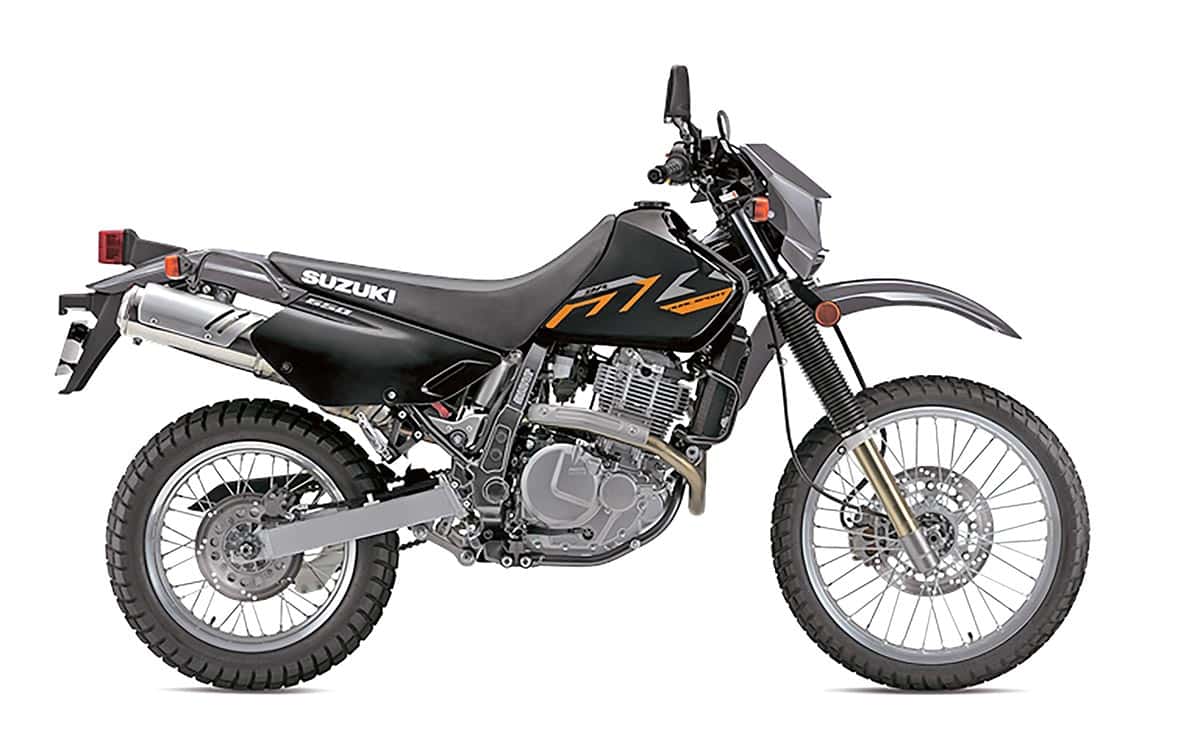We love technology but hate change. This is a basic contradiction that we have learned to live with. The Suzuki DR650S is one of those bikes that brings our various shortcomings to the surface. On one hand, we love the fact that Suzuki has stubbornly kept the DR in its line for over 32 years. On the other, it’s still a 32-year-old motorcycle.
That’s not necessarily bad; as it turns out, the bikes of that time had a lot to offer, but you do have to adjust your expectations. The fact that the Suzuki dual-sport is still offered seems almost impossible in the face of modern emission requirements. It’s a big, air-cooled single with a carburetor that sells for $6999. That’s the same price as a Yamaha YZ125. Another remarkable fact is that the DR is still made in Japan. Most other street-legal motorcycles in this price range are manufactured in China, Thailand or Vietnam. The DR is clearly the last of a nearly extinct species.
LOOKING BACK
There aren’t that many riders around who remember, but the DR650S’s bloodline can actually be traced back to the ’70s. The first four-stroke off-road bike that Suzuki manufactured was the 1978 SP370. It was a two-valve, air-cooled, five-speed four-stroke with a kick-starter. In 1981, the SP was punched out to a 500 and actually began to look like the present-day DR. That was when it got a four-valve head and double counterbalancers. A single-year SP600 appeared in 1985, and then the official beginning of the DR650S came in 1991. In 1993 it became the DR650SE with the introduction of the electric starter. That was a huge step forward and was fundamentally the same as the bike we have today. In 2001 and 2006, it received a few updates, and along the way, the big Dakar-inspired fuel tank was reduced in capacity.
If you look at the big-bore dual-sport world of the late ’90s, it’s clear that the DR was the Corvette of the class. It could easily outrun the Kawasaki KLR650 and the Honda XR650L of the period. In terms of handling, it fell right between the dirt-inspired Honda and the street-oriented Kawasaki.
THE DR TODAY
Today’s DR650S hasn’t changed, but its role in the market has. It’s not a performance bike anymore—if it ever was. It’s not really a dual-sport bike by the present-day definition of the term, either. It’s more of an adventure bike starter kit. The first thing that might give away the ’90s vintage is the layout. It has a thick seat with a distinct saddle area. You sit in a little cockpit with handlebars that sweep back to your hands. When you stand, you actually feel like the bars are behind you. The bar bend is definitely of an era. The handlebar itself is steel with a crossbar—very ’90s-like. Suzuki was clearly concerned about vibration; on the ends of the bars are little weights to help quell vibes. The footpegs are rubber-mounted as well. Vibration isn’t much of a factor. The motor produces a low-frequency rumble that’s actually kind of pleasant.
The power delivery is exactly what you would expect from an old-school big single. It’s all torque and no revs. We can understand why this bike has withstood the test of time. There’s something very satisfying about opening the throttle at low rpm and experiencing its chunky, uneven acceleration. The DR actually produces more torque than any of the modern 500-class dual-sport bikes. In peak power it falls down simply because it doesn’t rev out. When you get to 7000 rpm, it’s done, whereas a more modern bike is just getting started. The Suzuki has very tall gearing, too, which serves to keep it at low rpm and exploit all that torque.
That’s fine for long rides on dirt roads and two-track. You can cruise at low rpm all day in relative comfort. If you decide you want to go fast or venture onto real trails, you might be getting in over your head. First gear is very tall, and the tires are extremely street-oriented. On most dual-sport bikes, the first thing we do is install more aggressive rubber. That would be a waste of time in this case. Full knobs would wear out faster and be only slightly less miserable in sand and loose dirt. The next problem is the archaic suspension. It’s soft and offers no adjustability, aside from a secondary shock mount designed to reduce seat height. Beyond that, the bike is heavy. Suzuki says it has a curb weight of 366 pounds, but we’re fairly sure it’s much more. We didn’t put it on our scale this year because we currently don’t have a chiropractor on staff. Back in 2013 we did, and it was 388 without fuel. In sand, it sinks and wallows. In its defense, it sinks and wallows less than a new Kawasaki KLR650.

WHERE WE STARTED
The KLR650 remains the Suzuki DR650’s closest rival after all these years. That bike was reissued with a few updates and fuel injection last year. The Suzuki is still the same bike, carburetor and all. On a bike like this, there’s nothing wrong with that; fuel injection simply adds complexity and cost. So, is there still a place for the DR650S in the modern world? Absolutely. We don’t know how it has lasted this long, but if it were up to us, the DR would be with us forever.
So far, it’s about halfway there.






Comments are closed.